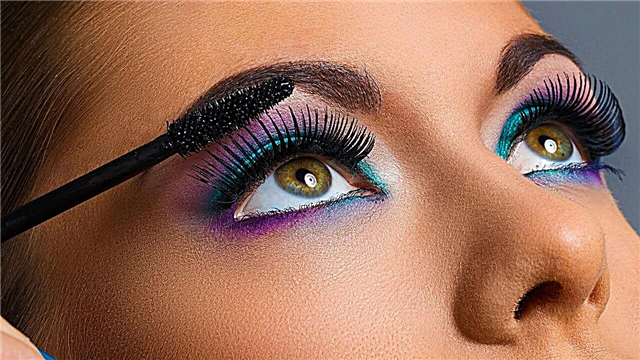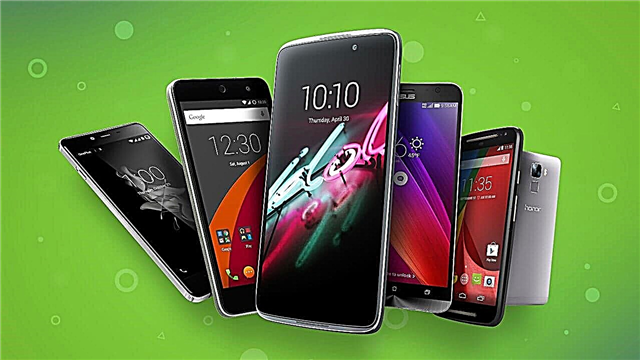In 1999, the best-selling Nokia 3210 mobile phone was 16.7-22.5 mm thick (the largest thickness was in the screen area) and for its dimensions earned the nickname "walnut cracker".
Fast forward to 2019, and compare the fat Nokia 3210 with the much more elegant and incomparably more powerful Apple iPhone Xs Max and Samsung Galaxy S10 +.
But, no matter how amazing it may sound, not one of them deserves the title of “thinnest smartphone of 2019”. After all, Android users can afford to choose from a number of ultrathin smartphones from different manufacturers. And in this rating we have collected the thinnest of them. The list includes only models 2018-2019. release.
10. LG G7 ThinQ
 The average price is 27,690 rubles.
The average price is 27,690 rubles.
Specifications:
- smartphone with Android 8.0
- dual SIM support
- 6.1 ″ screen, resolution 3120 × 1440
- dual camera 16 MP / 16 MP, autofocus
- 128 GB memory, memory card slot
- 3G, 4G LTE, LTE-A, Wi-Fi, Bluetooth, NFC, GPS
- 6 GB RAM
- 3000 mAh battery
- weight of 163 g, WxHxT 71.90 × 153.20 × 7.90 mm
- separate DAC
LG's new flagship comes with a massive 6.1-inch Quad HD + Full Vision display. This is a tall model with an aspect ratio of 19.5: 9, and at the same time very thin. Its display has a cutout similar to the iPhone XS, which houses the front camera. However, it can be hidden using the settings in the interface.
Also, this smartphone boasts a dual 16-megapixel camera (two 16 MP sensors), which gives you the ability to take wide-angle shots, as well as a powerful Snapdragon 845 processor. All these features make the LG G7 ThinQ one of the best smartphones up to 30,000 rubles.
Pros: Military Standard 810G protection, 3.5 mm audio jack, fast charge.
Cons: not a very powerful battery.
9. Samsung Galaxy S10 +
 The average price is 124 139 rubles.
The average price is 124 139 rubles.
Specifications:
- smartphone with Android 9.0
- dual SIM support
- 6.4 ″ screen
- three cameras 16 MP / 12 MP / 12 MP, autofocus
- 1024 GB memory, memory card slot
- 3G, 4G LTE, LTE-A, Wi-Fi, Bluetooth, NFC, GPS, GLONASS
- RAM 12 GB
- battery 4100 mAh
- weight 175 g, WxHxT 74.10 × 157.60 × 7.80 mm
At the moment, this is the best flagship of the Korean tech giant, its thickness is only 7.8 mm.
The back of the phone is made of glass, which is undoubtedly very beautiful, but not very practical. The huge display with Super AMOLED panel has perfect color reproduction, a large margin of brightness and good contrast performance.
Inside the Galaxy S10 + there is up to 12 GB of RAM and the top-end Samsung Exynos 9820 processor, which also provides fast charging functions. Despite all of this cutting-edge technology inside, the Galaxy S10 is thinner than many modern mobile phones.
Pros: a powerful, beautiful, waterproof smartphone that has everything you need for comfortable operation, even such a trifle as a 3.5 mm audio jack.
Cons: high price.
8. OnePlus 6
 The average price is 29,400 rubles.
The average price is 29,400 rubles.
Specifications:
- smartphone with Android 8.1
- dual SIM support
- 6.28 ″ screen, resolution 2280 × 1080
- dual camera 16 MP / 20 MP, autofocus
- 128 GB memory, without memory card slot
- 3G, 4G LTE, LTE-A, Wi-Fi, Bluetooth, NFC, GPS, GLONASS
- 8 GB RAM
- 3300 mAh battery
- weight 177 g, WxHxT 75.40 × 155.70 × 7.75 mm
There are few devices on the mobile market that can come close to OnePlus 6 in terms of price and quality.
This smartphone has an excellent AMOLED display with a 19: 9 aspect ratio and Gorilla Glass 5 protective glass, a very fast and energy-efficient Snapdragon 845 processor (it consumes 30% less energy compared to the 835th) and a large amount of RAM.
The main camera has optical stabilization, very fast autofocus and macro mode. As a result, the photos are bright and saturated even in low light.
The manufacturer even took care of such necessary trifles as a protective case and a film, they are included.
Pros: there is fast charging, there is face recognition, there is a 3.5 mm audio jack.
Cons: you can not expand the amount of memory storage,
7. Apple iPhone Xs Max
 The average price is 96,990 rubles.
The average price is 96,990 rubles.
Specifications:
- smartphone with iOS 12
- dual SIM support (nano SIM + eSIM)
- 6.5 ″ screen, resolution 2688 × 1242
- dual camera 12 MP / 12 MP, autofocus
- 256 GB memory, without memory card slot
- 3G, 4G LTE, LTE-A, Wi-Fi, Bluetooth, NFC, GPS, GLONASS
- weight of 208 g, WxHxT 77.40 × 157.50 × 7.70 mm
This is one of the best-selling smartphones on the market, and also one of the thinnest. iPhone Xs Max has one of the best displays that a modern mobile device can offer, and is also equipped with advanced face recognition technology.
The device runs on the latest A12 Bionic chipset, so you can easily run the most demanding applications and games.
Pros: superior rear and front cameras, supports fast and wireless charging.
Cons: overpriced, very slippery case.
6. Honor 10
 The average price is 21 900 rubles.
The average price is 21 900 rubles.
Specifications:
- smartphone with Android 8.1
- dual SIM support
- screen 5.84 ″, resolution 2280 × 1080
- dual camera 16 MP / 24 MP, autofocus
- 128 GB memory, without memory card slot
- 3G, 4G LTE, LTE-A, Wi-Fi, Bluetooth, NFC, GPS, GLONASS
- 4 GB RAM
- 3400 mAh battery
- weight of 153 g, WxHxT 71.20 × 149.60 × 7.70 mm
If you need a thin, beautiful and powerful phone - then it is in front of you. Honor 10 is convenient to operate with one hand due to the relatively small screen size, and inside the case there is a good 3400 mAh battery with fast charging function, and the HiSilicon Kirin 970 processor, which is slightly inferior in its capabilities to the 2018 flagship chipset Snapdragon 845.
The AI rear camera takes superb shots automatically. However, for professionals there is a Pro mode with a lot of subtle settings. The front camera has a standard beauty mode for modern smartphones, and makes perfect selfies that are not ashamed to share on social networks.
Pros: instantly working fingerprint scanner, it is easy to read text on the screen even under the bright sun.
Cons: you can not increase the amount of memory.
5. Samsung Galaxy A50
 The average price is 19,990 rubles.
The average price is 19,990 rubles.
Specifications:
- smartphone with Android 9.0
- dual SIM support
- 6.4 ″ screen, resolution 2340 × 1080
- three cameras 25 MP / 8 MP / 5 MP, autofocus
- 64 GB memory, memory card slot
- 3G, 4G LTE, LTE-A, Wi-Fi, Bluetooth, NFC, GPS, GLONASS
- 4 GB RAM
- 4000 mAh battery
- weight of 166 g, WxHxT 74.70 × 158.50 × 7.70 mm
For the most part, the smartphone market is divided into two segments. There are high-end devices with the highest build quality, innovative features and the most modern chipsets, as well as mid-range and budget smartphones with adequate, but not mind-blowing performance.
Samsung Galaxy A50 is the golden mean, combining excellent build quality and premium features such as an NFC module and an integrated fingerprint scanner with a mid-level chipset and sufficient, but not flagship RAM.
It features a Super AMOLED touchscreen, an Exynos 9610 processor and a Mali-G72 MP3 video processor and 4 GB of RAM. At the back is a triple camera, which is strange to see in a good smartphone up to 20 thousand rubles. It allows you to take detailed and wide-angle shots even in low light conditions.
Due to the high screen-to-body ratio, the Galaxy A50 is not difficult to hold with one hand.
Pros: there is a quick charge, there is a 3.5 mm headphone jack, there is face recognition.
Cons: There is Always on display, but there is no indicator of a missed event, the fingerprint scanner periodically “dulls”.
4. HUAWEI P20
 The average price is 28,799 rubles.
The average price is 28,799 rubles.
Specifications:
- smartphone with Android 8.1
- dual SIM support
- 5.8 ″ screen, resolution 2240 × 1080
- dual camera 12 MP / 20 MP, autofocus
- 128 GB memory, without memory card slot
- 3G, 4G LTE, LTE-A, Wi-Fi, Bluetooth, NFC, GPS, GLONASS
- 4 GB RAM
- 3400 mAh battery
- weight 165 g, WxHxT 70.80 × 149.10 × 7.65 mm
This elegant and stylish smartphone in a glass-metal case has beautifully rounded corners. Its display has increased brightness thanks to RGBW technology, in which another white color is added to the standard three sub-pixels.
The device has a fairly capacious battery, HiSilicon Kirin 970 chipset and Mali-G72 MP12 graphics processor, so that performance will not be a problem, and the same goes for battery life.
Another strength of the HUAWEI P20 is the dual camera with the neural network algorithm Master AI. He is responsible for automatically determining the shooting scenario and adjusting the frame parameters. As a result, you get the most clear, bright and detailed photo.
Pros: excellent design, there is a fast charge.
Cons: there is no 3.5 mm audio jack (an adapter is included), the rear camera protrudes slightly from the case, you can not increase the amount of memory.
3. Vivo X21
 The average price is 24,489 rubles.
The average price is 24,489 rubles.
Specifications:
- smartphone with Android 8.1
- dual SIM support
- 6.28 ″ screen, resolution 2280 × 1080
- dual camera 24 MP / 5 MP, autofocus
- 128 GB memory, memory card slot
- 3G, 4G LTE, Wi-Fi, Bluetooth, GPS, GLONASS
- 6 GB RAM
- 3900 mAh battery
- weight of 156 g, WxHxT 74.78 × 154.45 × 7.37 mm
You may know that it was this Chinese manufacturer in December 2014 that introduced the thinnest smartphone at that time - Vivo X5 Max. Its thickness was only 4.75 mm. However, he was circumvented by the Coolpad Ivvi K1 Mini, performing in an "extremely light physique" with its 4.7 mm. However, Vivo smartphones are still known as one of the thinnest smartphones on the market. And the Vivo X21 is no exception.
However, in addition to the dimensions of this model, there is something to brag about. For example, a large AMOLED screen with rich color reproduction and a good aspect ratio of 19: 9, a mid-price Snapdragon 660 processor and a large amount of RAM, as well as an AK4376A Hi-Fi audio processor. The latter provides stable and clear sound and 0.1% distortion when working with headphones.
Pros: bright and detailed photos from the rear and front cameras, there is fast charging, there is a 3.5 mm headphone jack, the kit includes a silicone case and stereo headphones with ear pads and a microphone.
Cons: no NFC, outdated micro-USB connector, overpriced.
2. Xiaomi Mi A2
 The average price is 12,400 rubles.
The average price is 12,400 rubles.
Specifications:
- smartphone with Android 8.1
- dual SIM support
- 5.99 ″ screen, resolution 2160 × 1080
- dual camera 12 MP / 20 MP, autofocus
- 64 GB memory, without memory card slot
- 3G, 4G LTE, LTE-A, Wi-Fi, Bluetooth, GPS, GLONASS
- 4 GB RAM
- battery 3010 mAh
- weight of 168 g, WxHxT 75.40 × 158.70 × 7.30 mm
This mobile phone is unlikely to take the main prize for a beautiful design. But for those who are looking for a thin device with a good screen, decent performance and low price, the Mi A2 will become a real treasure.
It is equipped with a 5.99-inch display with an aspect ratio of 18: 9, reinforced with damage-resistant coating Gorilla Glass 5, as well as a 20-megapixel front camera, which is one of the best in the price category “up to 20 thousand rubles”.
This model runs on the high-performance hardware platform Snapdragon 660 in combination with the Adreno 512 video accelerator. Modern games without lags run on it at medium and low settings.
Pros: there is a quick charge, a protective case is included, the rear camera takes excellent pictures even “out of the box”, without manual adjustment.
Cons: there is no 3.5 mm connector (there is an adapter), you can not make contactless payments, you can not increase the amount of memory.
1. NTT Docomo Card Keitai KY-01L
 The average price is 32,000 yen (19,315 rubles).
The average price is 32,000 yen (19,315 rubles).
Specifications:
- modified Android smartphone
- 2.8-inch black and white screen with a resolution of 600 × 480 pixels
- 8 GB memory, without memory card slot
- 3G, 4G LTE, LTE-A, Wi-Fi, Bluetooth, GSM
- 1 GB RAM
- 380 mAh battery
- weight 47 g, WxHxT 55.88 × 91.44 × 5.30 mm
While Apple, Google and other phone manufacturers are launching smartphones with a lot of “twists”, the largest Japanese mobile operator NTT Docomo has released a smartphone that follows a different trend: to be as light and easy to use as possible.
NTT Docomo claims that its phone is the “thinnest” smartphone in the world and is the size of a credit card. It is made of black plastic, very light and fits not only in your pocket, but also in a large wallet.
At the same time, the Card Keitai KY-01L is more likely not an independent, but an auxiliary device designed for those who already have large smartphones. It is easy to use, convenient to move, and offers the most necessary - calls and short text messages.
“This stream of so-called companion phones reflects the desire of phone manufacturers to find new sales opportunities in a saturated market,” said Ben Wood, chief analyst at research firm CCS Insight.
“A small companion phone looks like an attractive idea on paper, but such devices are usually a compromise (in terms of specifications), and in addition, consumers must pay for them in addition to existing smartphones, and often pay extra for mobile communications,” He added.
Software and hardware Card Keitai KY-01L
This phone is equipped with a 2.8-inch black and white screen, which is made by technology E-Ink (electronic ink). You must have come across it if you use e-books. Such a screen saves the battery, and it is convenient to read from it even on the street on a sunny day. However, Card Keitai KY-01L has highlights, so the text will be illegible in the dark.
Card Keitai KY-01L is running a modified Android OS, but you cannot install applications
The phone has LTE and 4G connectivity for phone calls and web browsing. However, it does not have a camera, voice assistant or store for downloading applications.

Here is a complete list of his applications:
- Dialer.
- Web browser
- The calendar.
- SMS
- Clock.
- Calculator.
- Notebook.
- Settings menu.
Out of 8 GB of internal storage, only 5 GB is available to the user. However, this volume is enough to upload photos from a computer to a phone, and set them instead of wallpaper.
As a hardware platform, the manufacturer chose the quad-core Snapdragon Wear 2100 processor with a clock frequency of 1.2GHz. Usually this is installed in wearable devices.
To please the dimensions, I had to sacrifice a loudspeaker, with the exception of the auditory speaker. Therefore, when dialing a number, not a melody is heard, but a tone. It is heard when the buttons are pressed.
Super Lightweight Battle
Is it possible to say that Card Keitai KY-01L is the thinnest smartphone in the world? Of course, there are phone makers who could say the opposite. For example, the Vivo X5 Max and Coolpad Ivvi K1 Mini models have a thickness of just under 5 mm, although Docomo would no doubt indicate that Chinese manufacturing companies are cheating without considering the camera sticking out of the case. On the other hand, Vivo and Coolpad may argue that Docomo cheated without even turning the camera on her smartphone.
Pros: IPX2 waterproof rating (withstands splashes of water droplets sprayed at a distance of 20 cm), the battery lasts 7 days when the phone is in standby mode.
Cons: the lack of front and rear cameras, you can not increase the amount of memory.












